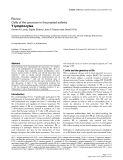
Predisposition to disease
-
Steven K Lundy, Sujata Sarkar, Laura A Tesmer and David A Fox Department of Internal Medicine, Division of Rheumatology and Rheumatic Diseases Core Center, University of Michigan Medical School, 4043 Biomedical Sciences Research Bldg., 109 Zina Pitcher Pl., Ann Arbor, MI 48109-2200, USA Corresponding author: David A Fox, dfox@umich.edu Published: 13 February 2007 This article is online at http://arthritis-research.com/content/9/1/202 © 2007 BioMed Central Ltd Arthritis Research & Therapy 2007, 9:202 (doi:10.
 11p
11p  thulanh13
thulanh13
 15-10-2011
15-10-2011
 59
59
 1
1
 Download
Download
CHỦ ĐỀ BẠN MUỐN TÌM













